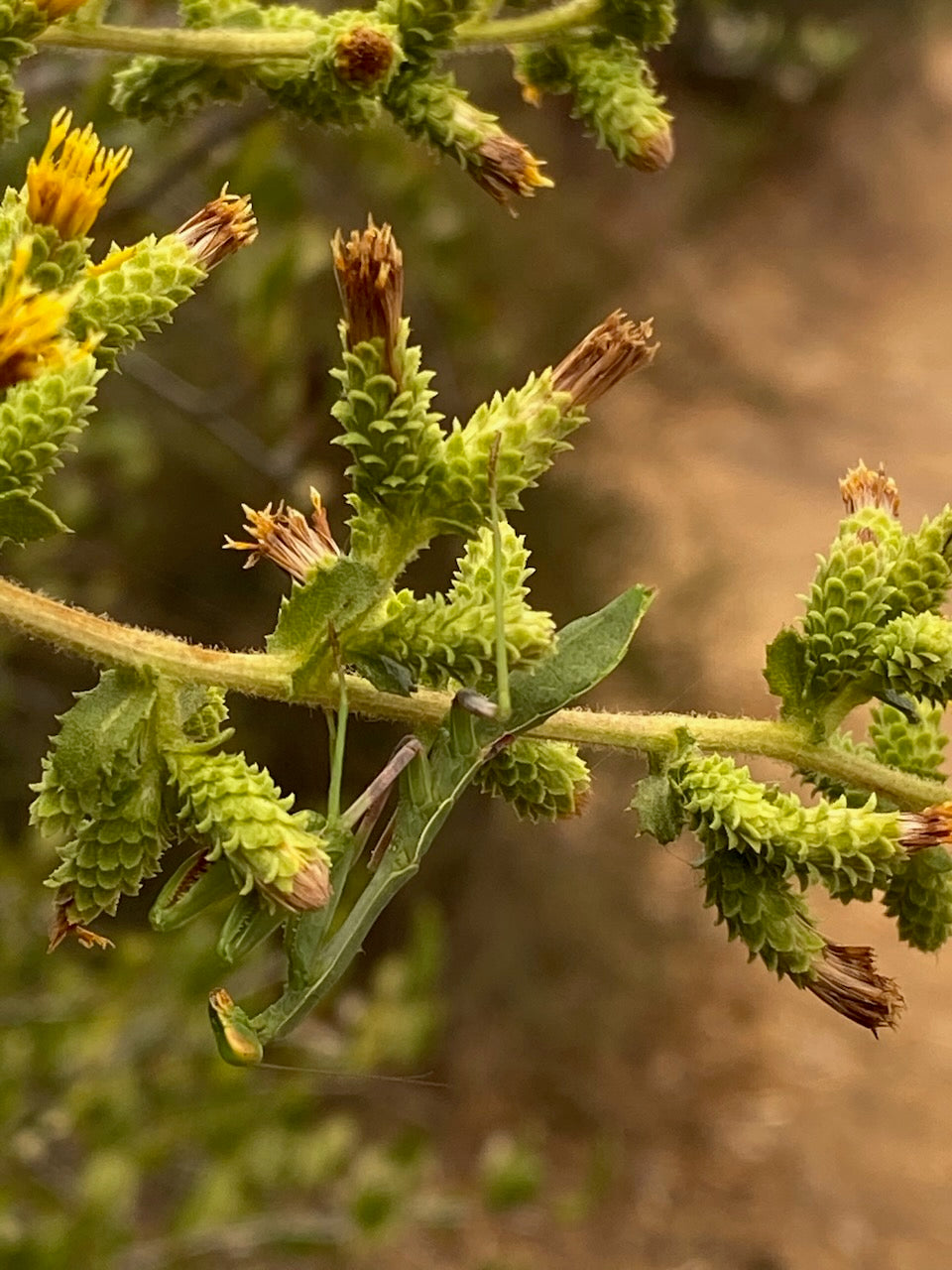
Therapeutics of Santa Barbara Goldenbush: A Medicinal California Native Herb Profile
Share
Hazardia squarrosa — California Goldenbush
Synonym: Haplopappus squarrosus
Also called: Sawtooth Goldenbush, Common Hazardia
Family: Asteraceae (Sunflower Family)
Pharmaceutical name: Herba Hazardiae squarrosae
Experience Goldenbush Firsthand
Discover our artisan-distilled California Goldenbush Essential Oil, carefully wildharvested on private ranch land and distilled in small batches at Refugio Gardens. This rare aromatic carries a bright, sweet-green, lightly lemony fragrance with soft resinous warmth.
Quick-Start Use Guide
Topical (Essential Oil, Always Diluted)
- Patch test first. For general calm and comfort, use 1–2 drops EO per 1 tsp (5 mL) carrier and apply to pulse points or back of neck.
- For areas of tension or “Qi stagnation,” massage diluted EO over shoulders, abdomen (clockwise), or tense muscles.
Hydrosol (Traditional, Gentle)
Use as a room or linen mist for uplift and balance. Some practitioners sip 2 Tbsp hydrosol in 1 L water through the day for a soothing, mood-settling effect (professional guidance advised).
Inhalation
Diffuse 2–4 drops to create an uplifting, sweet-green atmosphere for reflection, meditation, or creative work.
Safety: Keep away from eyes/mucosa; discontinue if irritation occurs. Avoid during pregnancy. Internal use (including hydrosols) should be guided by a qualified practitioner.
See teas, baths & topical preparations • Research & chemistry • FAQ
Characteristics
- Plant: Sweet, slightly bitter, aromatic, neutral
- Essential Oil: Top Note: Citrus-pine opening into a sweet floral-green heart. Middle Note: Jasmine–pear–gardenia evolving into a soft fermented apple–pear cider. Base Note: Warm resinous-balsamic drydown and gentle camphoraceous clarity.
- Hydrosol: Softer and greener than the oil; sweet herbal with floral freshness
Channel Tropism (TCM)
- Liver
- Heart
Western Actions
Traditionally described as antirheumatic and mildly euphoric.
Chinese Medicinal Actions & Indications
- Alleviates Pain & Circulates Qi: Topical support where Qi stagnation contributes to aches and pains.
- Calms the Mind: For mild shen disturbance and Heart/Liver deficiency patterns with low mood or restlessness.
Cautions & Contraindications
- Patch test before topical use; discontinue if irritation occurs.
- Avoid during pregnancy.
- Keep away from eyes and mucous membranes.
- Internal use (including hydrosols) should be guided by a qualified practitioner.
Clinical Information
Clients describe Goldenbush oil and hydrosol as simultaneously uplifting and calming to the shen (mind/spirit). A diluted drop on pulse points or the back of the neck has been used for fatigue or low mood, while the hydrosol is often diffused as a gentle room mist to restore balance.
Traditional & Modern Preparations
- Warm Bath / Soak — Traditional external use: add EO (pre-dispersed in carrier) to warm bathwater for a resinous, relaxing soak that eases areas of tension.
- Topical Oil — 1–2% dilution (≈ 6–12 drops EO per 1 oz / 30 mL carrier) for local massage over shoulders, neck, or abdomen.
- Compress or Wash — A few drops of EO in carrier, then mixed into warm water and applied as a cloth compress to areas of discomfort.
- Hydrosol Room / Linen Mist — Spray for a bright, sweet-green lift; suitable for meditation or creative work.
Note: External/bath applications are the best-documented folk methods for Goldenbush. Use small amounts; discontinue if sensitivity occurs.
Modern Research & Chemistry Notes
Our laboratory GC–MS confirms a monoterpene-rich profile for Hazardia squarrosa, led by sabinene, β-pinene, limonene, and myrcene, with smaller amounts of 1,8-cineole and camphor. This profile explains the oil’s bright citrus-pine lift, sweet floral-green heart, and gently resinous drydown observed in practice. †
Perfume Note Breakdown
Top Notes (0–15 min)
- Sabinene → peppery-green brightness, uplifting sparkle
- β-Pinene → crisp pine clarity, sharp green focus
- Limonene → citrus radiance with mandarin-like lift
Middle (Heart) Notes (15 min–2 hrs)
- Myrcene → herbal depth, fruity-green softness
- β-Ocimenes (E/Z, minor) → floral-green lift, jasmine–pear nuance
- Overall heart: sweet floral-green facets reminiscent of jasmine, pear, and gardenia with a soft cider-like undertone
Base Notes (Drydown, 2–6 hrs)
- Trace sesquiterpenes (e.g., germacrene D, δ-cadinene, eudesmols) → resinous-balsamic warmth, grounding
- Camphor (minor) → gentle cooling clarity woven into the resinous base
Olfactory narrative: A citrus-pine sparkle opens into a sweet floral-green heart (jasmine–pear–gardenia with cider-like nuances), resolving to a warm resinous-balsamic drydown with subtle camphoraceous clarity. †
Major Known Plant Constituents
Essential Oil (GC–MS, Lot#923, 2023):
- Sabinene — 28.20% • Fresh, peppery note; studied for anti-inflammatory and antioxidant effects that support joint comfort and skin vitality.
- β-Pinene — 18.91% • Pine-like and uplifting; helps open the breath, calm stress, and shows antimicrobial and bronchodilatory activity.
- Limonene — 15.10% • Bright citrus aroma; known for mood-lifting, immune support, and antioxidant skin-protective actions.
- Myrcene — 10.51% • Earthy and herbal; associated with relaxation, muscle ease, and gentle anti-inflammatory benefits.
- 1,8-Cineole — 3.18% • Clean, eucalyptus-like note; supports clear breathing, focus, and has strong antimicrobial potential.
- Camphor — 3.15% • Cooling and invigorating; traditionally used for circulation, sore muscles, and easing congestion.
- α-Pinene — 2.83% • Crisp conifer scent; improves alertness and memory while also showing antimicrobial and anti-inflammatory effects.
- Terpinen-4-ol — 2.61% • Key component of tea tree oil; valued for antimicrobial and skin-soothing properties.
- (E)-β-Ocimene — 2.51% • Sweet, green, floral; linked to antioxidant action and mood-brightening qualities.
- γ-Terpinene — 1.61% • Citrus-herbal note; contributes antioxidant support and immune-modulating activity.
- Additional trace constituents (<1%) • Present in small amounts, adding to the full therapeutic synergy of the oil.
Surface Flavonoid Exudates (leaf/stem resin, literature reports):
- Eriodictyol — Potent antioxidant; helps protect skin from sun exposure and calm visible redness; contributes gentle bitterness.
- Luteolin, Diosmetin & Chrysoeriol — Ease irritation and environmental stress; supportive for sensitive skin.
- Quercetin, Kaempferol & Isorhamnetin — Well-studied trio that reduces oxidative stress, supports collagen, and soothes redness.
- Quercetagetin & Gossypetin derivatives — Flavonols that may brighten/evens look of skin tone; early research suggests broader healthy-aging support.
- Apigenin — Chamomile-related flavone known to calm itch and support relaxed mood.
Internal Flavonoid Glycosides (leaves/flowers):
- Quercetin, Kaempferol, Isorhamnetin, Luteolin & Apigenin glycosides — Water-soluble “reservoir” forms that can release active compounds, contributing antioxidant and anti-inflammatory benefits for skin resilience and overall wellness.
† Essential oil percentages from Refugio Gardens GC–MS analysis (Lot#923, 2023). Flavonoid classes documented by Clark & Wollenweber (1985) and Bohm & Stuessy (2001); percentages not reported in literature.
Experience Wild California
Bring the bright, uplifting essence of Hazardia squarrosa into your wellness rituals. Our California Goldenbush Essential Oil is sustainably wildharvested and artisan-distilled in small batches at Refugio Gardens.
California Goldenbush FAQ
What is California Goldenbush essential oil?
A rare artisan distillation from Hazardia squarrosa with a bright, sweet-green, lemony-resinous aroma.
Why is Goldenbush rare in distillation?
It is a native chaparral shrub distilled infrequently. Refugio Gardens produces limited artisan batches with careful habitat stewardship.
How do I use Goldenbush essential oil?
Diffuse for clarity and uplift; dilute in carrier oil for topical use (always patch test). Hydrosol works well as a room or linen mist.
Is it sustainably sourced?
Yes. Plants are wildharvested responsibly on private ranch land and distilled in small artisan runs at Refugio Gardens.
Disclaimer
This article is for educational purposes only. Goldenbush has a history of traditional use, but these statements have not been evaluated by the FDA. This content is not intended to diagnose, treat, cure, or prevent disease. Always consult a qualified health practitioner before using herbal products.
† For references and study details, see our References page.
